Call us on 2514578498
The challenge was to incorporate a found object into our work – yes, we said ‘work’, not quilt! Making a quilt OR item that contains quilting, incorporating a found object which will be sent by another AQ member taking part in the challenge. This challenge was judged by photograph only and part of the brief was to encourage people to practice their photography. All finished items had to fit into a 50 cm cube.
The found object had to be small (under 10 cm in height and 3 cm in depth), robust (no leaves or anything that could disintegrate) and is an item not usually used in sewing (no fabric, lace, buttons etc.) Items must fit into a 50 cm cube.
| Main Object | Odd object received | Artist, Title & Statement |
| The winner | ||
 |
 |
Isabel Nielsen
Day’s Eye My object was really interesting and I received a lot of information from the sender who was wonderful. I found the depth and weight of the object challenging so knew that my piece would have to be a 3D construction. I eventually built a little cardboard frame to support the object and was able to sew the soft parts and a hanger to it. It was great to be challenged to think out of the box.
|
| Merit award | ||
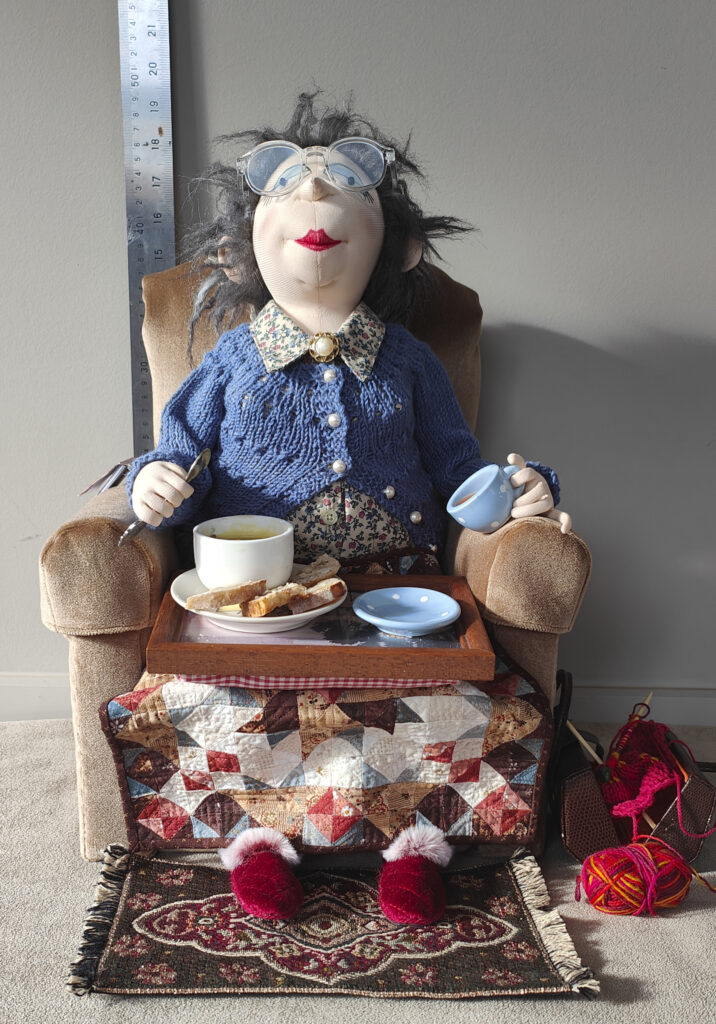 |
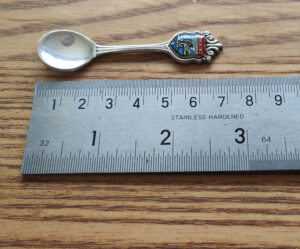 |
Sandie Sixtus
Pearl Witherspoon I was inspired by the spoon and felt it needs to be held so I adapted a Jill Maas doll pattern to create Pearl. Then I had to set the scene and made a chair and accessories for her. Her quilt and cushion are adapted from a Spoon block by Kate Quinn. Pearl has all she needs at hand and is easily distracted but always entertained. I have adapted or created the majority of her accessories.
|
| Best Photography | ||
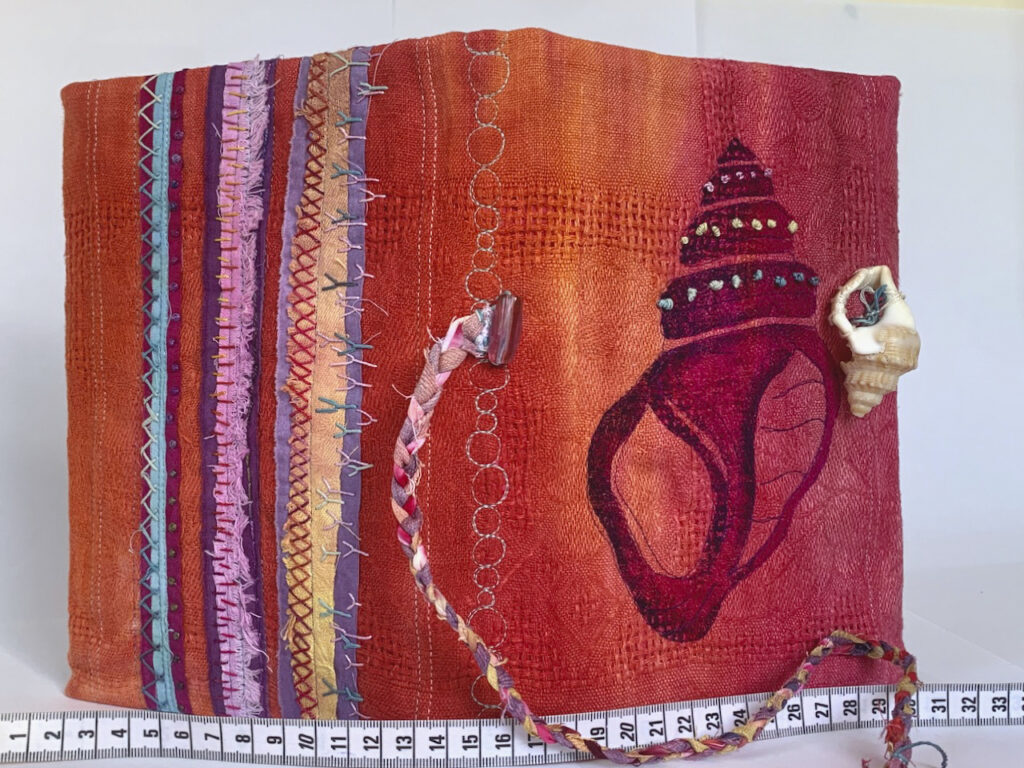 |
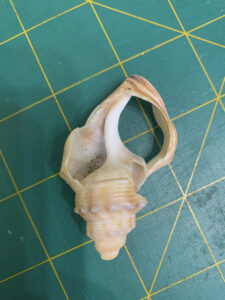 |
Charlotte Scott
‘Shell We Journal?’ The shell as an odd object stumped me a little, so I began to use it as surface design inspiration and worry about the work later. I carved a shell stamp and made a shell stencil and decorated fabric with them. And then I hit upon the idea to use the shell as a closure device on a journal cover. The plaited tie made of offcuts wraps around the journal and then around the shell and holds the book closed. The slow hand stitching on the back was just as meditative as journalling can be.
|
| Honourable mention for photography | ||
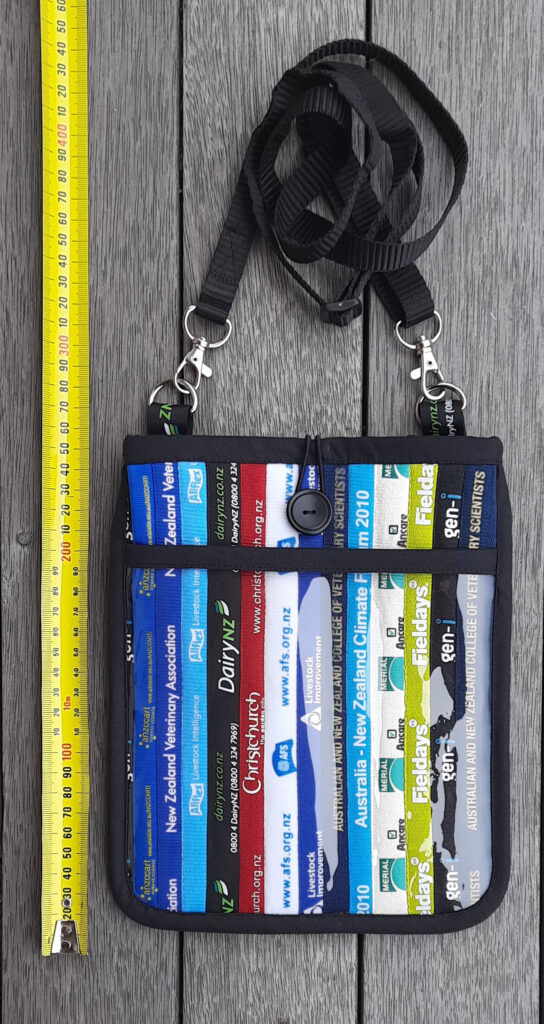 |
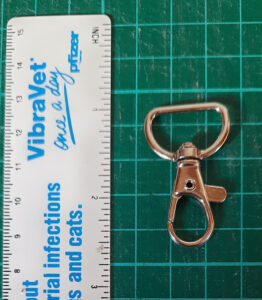 |
Nita Harding
Conference Junkie This bag is made from lanyard tapes collected at conferences and events. Each tape was attached to batting and backing fabric in a quilt as you go method, then the quilt sandwich was cut into the front and back pieces of the bag. The sides and top of the bag are bound to join and finish off. I found an additional matching swivel hook and used this and the sent odd object to attach the bag strap. The bag has a vinyl outer pocket, an inner mesh pocket, a button closure and adjustable strap. |
| The rest in alphabetical order by surname: | ||
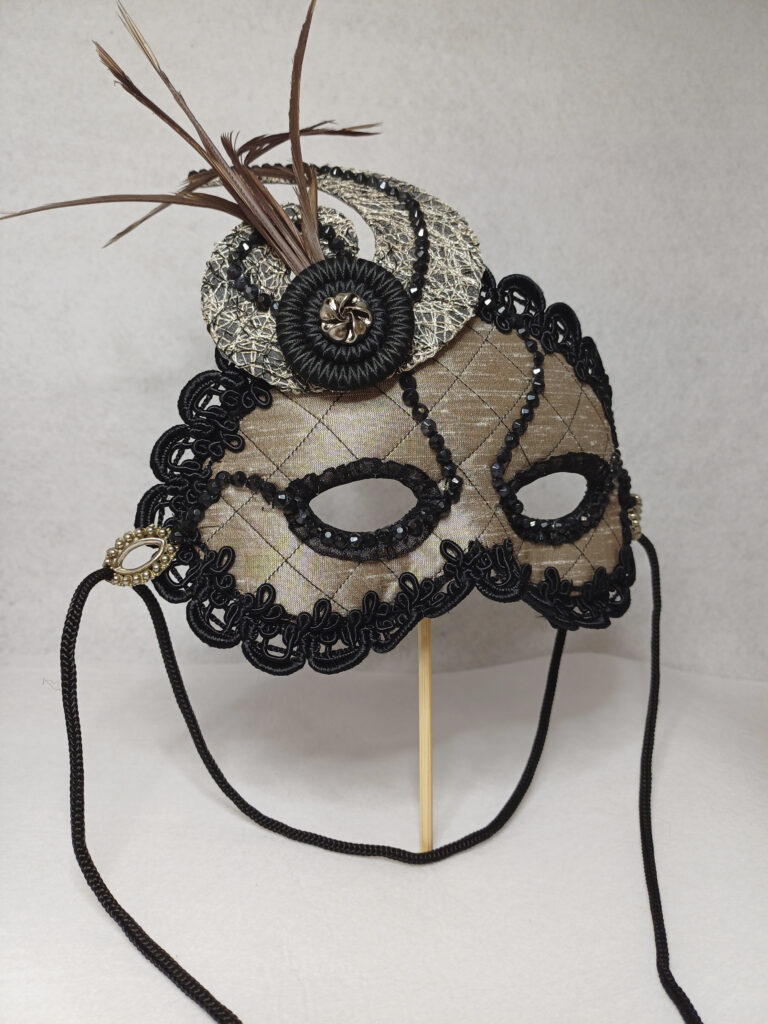 |
 |
Kaye Amos
In disguise The two pieces of jewellery arrived joined together, and instantly resembled a miniature pair of eyeglasses. They are elaborate and have a elegant flair to them. |
 |
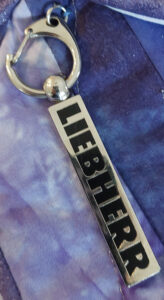 |
Annette Blair
Attached As many women have discovered, it is frustrating scrabbling into the depths of your handbag trying to locate your keys. The solution is to attach them with a clip to the outside of your bag. Problem solved. |
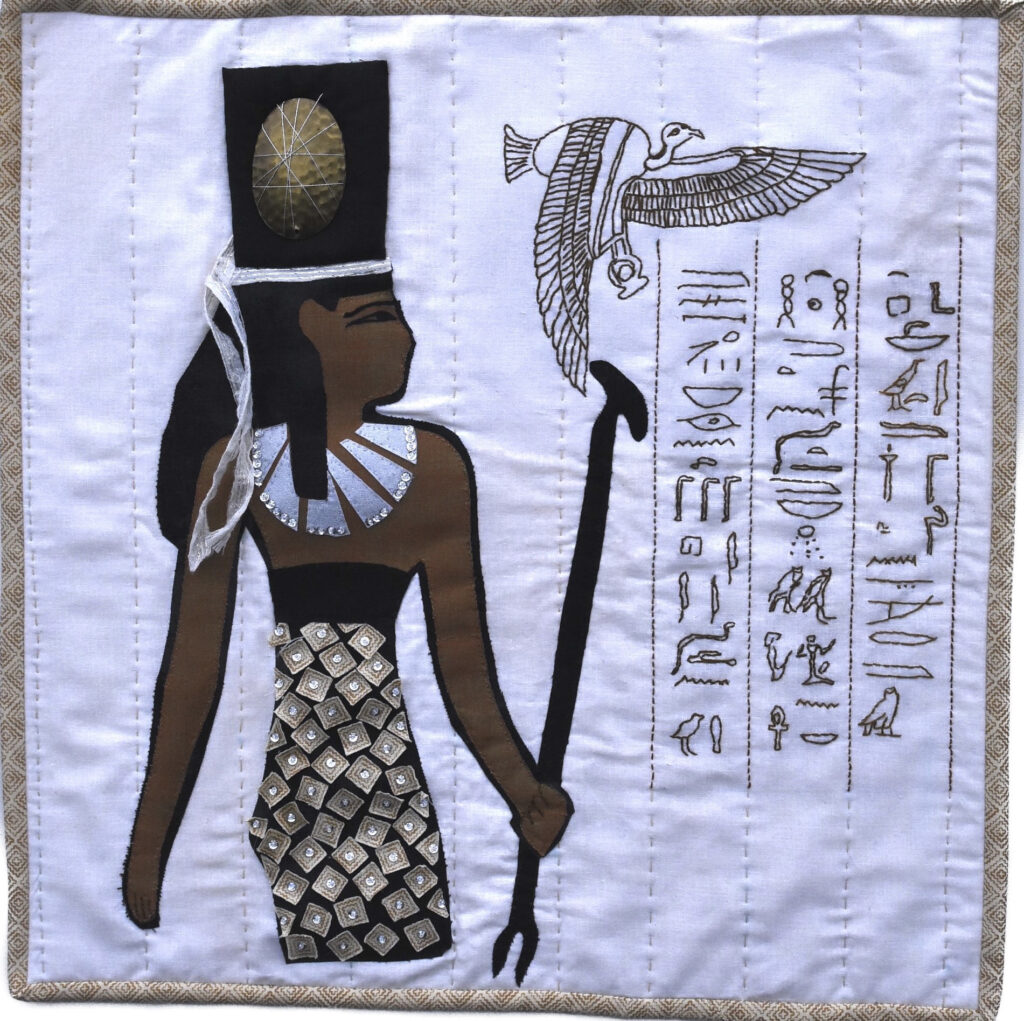 |
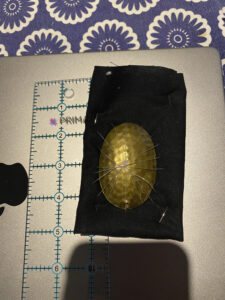 |
Sally Boult
Egyptian Inspired by the beaten gold detail on the odd object. Based on Egyptian artwork. Hand stitched apart from the binding. Includes embroidery, quilting, beading, raw edge applique. |
 |
 |
Brenda Carruthers
Faerie House My odd object was so beautiful and I wanted to do something special in soft tones to suit the flower. Faerie House was born! It is lovely to be making something three dimensional. |
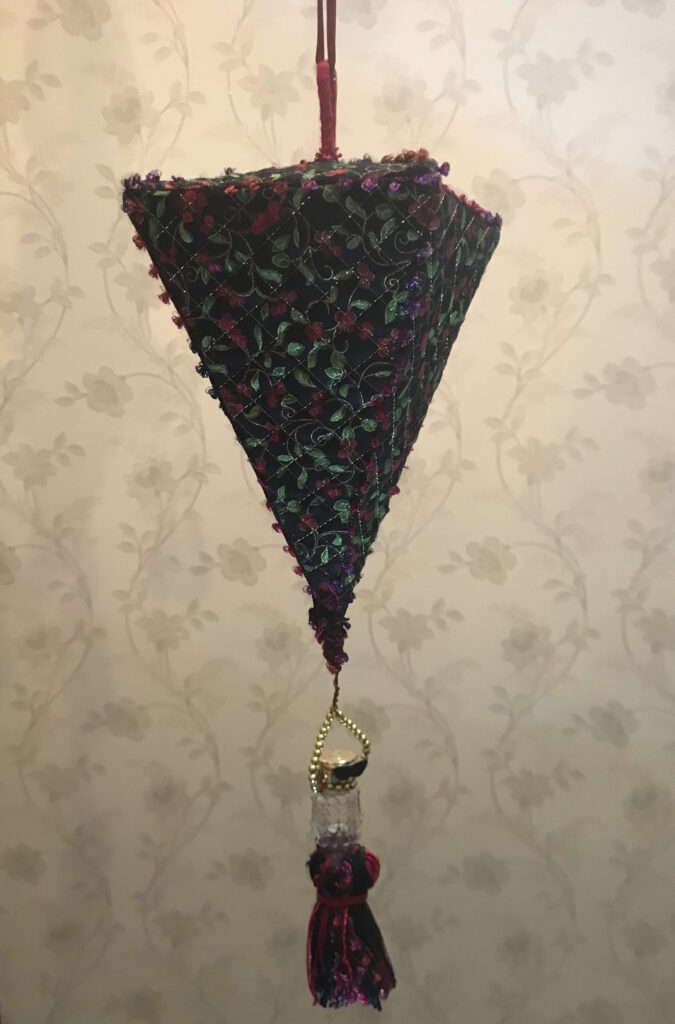 |
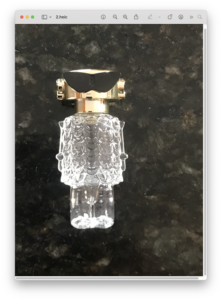 |
Cindy Dobbin
A Christmas Tassel My challenge took some thinking and many mockups. I finally decides to make a prism and attach the perfume bottle as part of the tassel. |
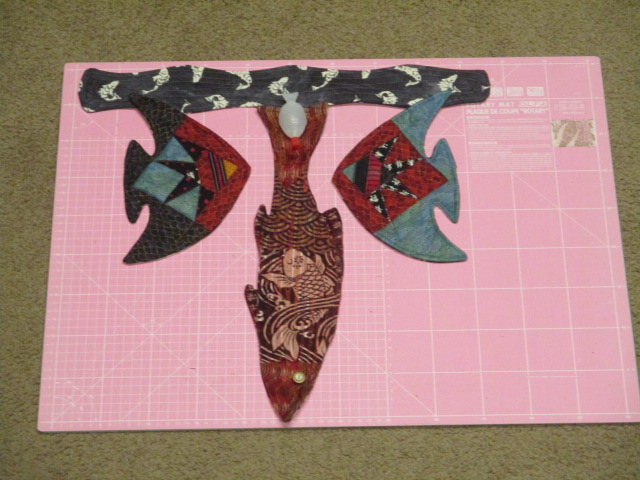 |
 |
Juliet Fitness
Angelic Japanese Sushi Fish My object is the sushi sauce bottle, which my object sender’s husband doesn’t like. Of course fish had to feature in my entry. The Japanese black and white fish fabric was in my stash. The angel fish feature the paper-foundation pieced Peaky and Spiky block (reduced in size) by the late Doreen Speckman. The centre fish has red organza chenilled on it. I decided to bag out all the fish, a job that became increasingly hard with the fishes fins. Machine pieced and quilted. |
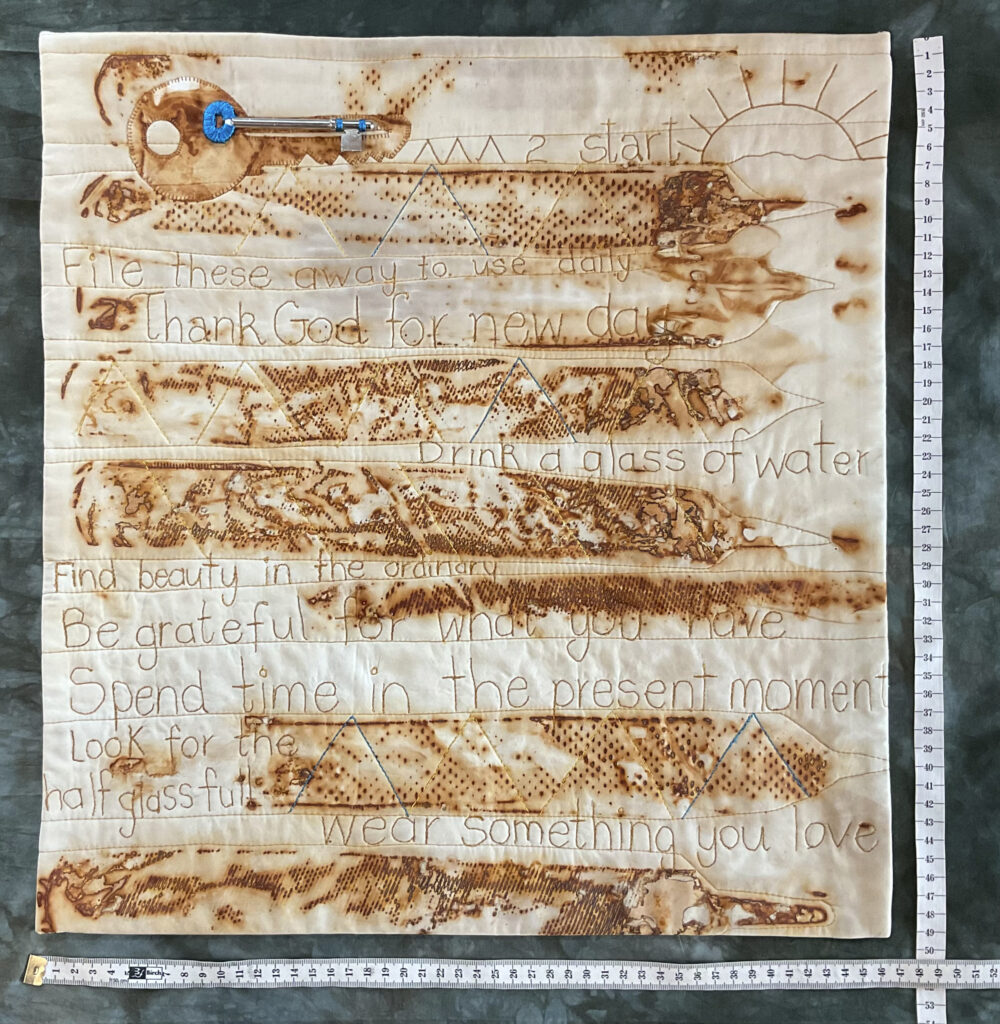 |
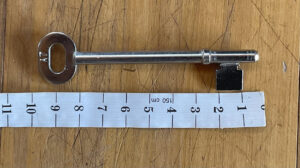 |
Merrilyn George
File these Key Points Unwrapping my fabric parcel with beautiful rusted images of old files imprinted, gave me the start for the “Key” object. These Key Points are a daily start reminder, and will hopefully enhance the day. |
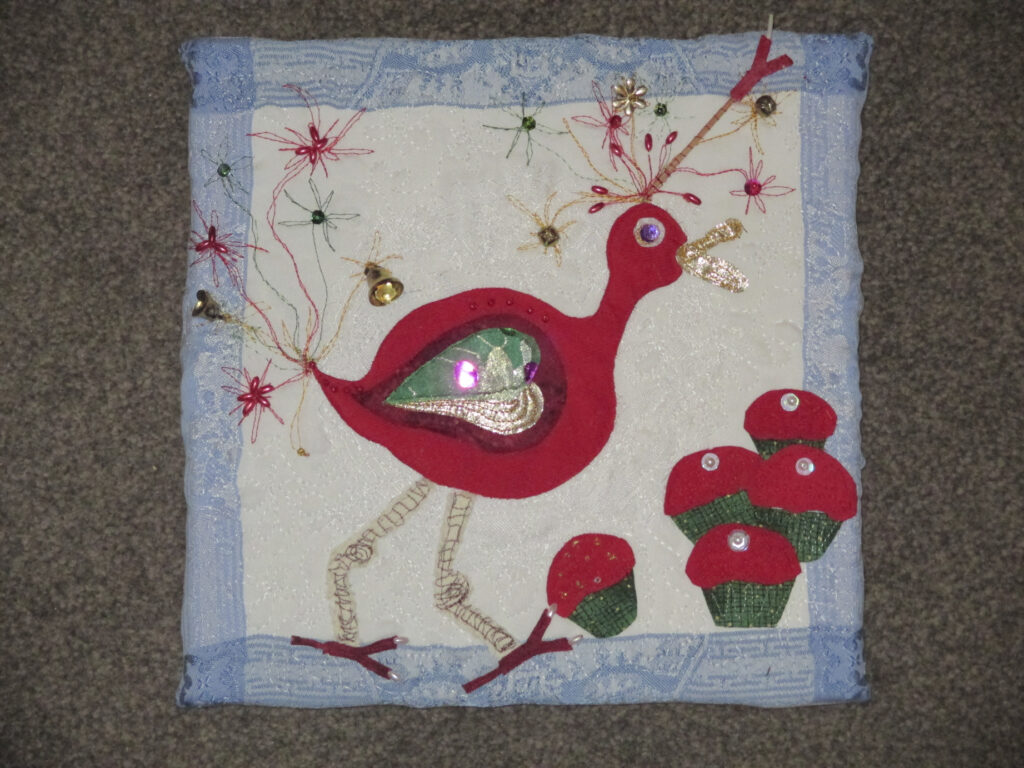 |
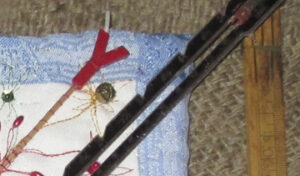 |
Yvonne Gilmore
Duckus destructis delicatanous Only found in delicatessens and patisseries, Duckus Destructis love all baked goods and pastries. It hides in amongst the red velvet cupcakes, using its specially adapted feet to forage amongst the baked good for it’s favourite decorations – candles! It’s duck bill scoops up icing and decorations with ease, the richer the better. The birds are seldom spotted, and are rare except in wealthy suburbs and, of course, anywhere French. Akaroa is a favourite site. |
 |
 |
Barbara Hilford
Plume or Bloom? Feather or Flower.? The choice is yours…. |
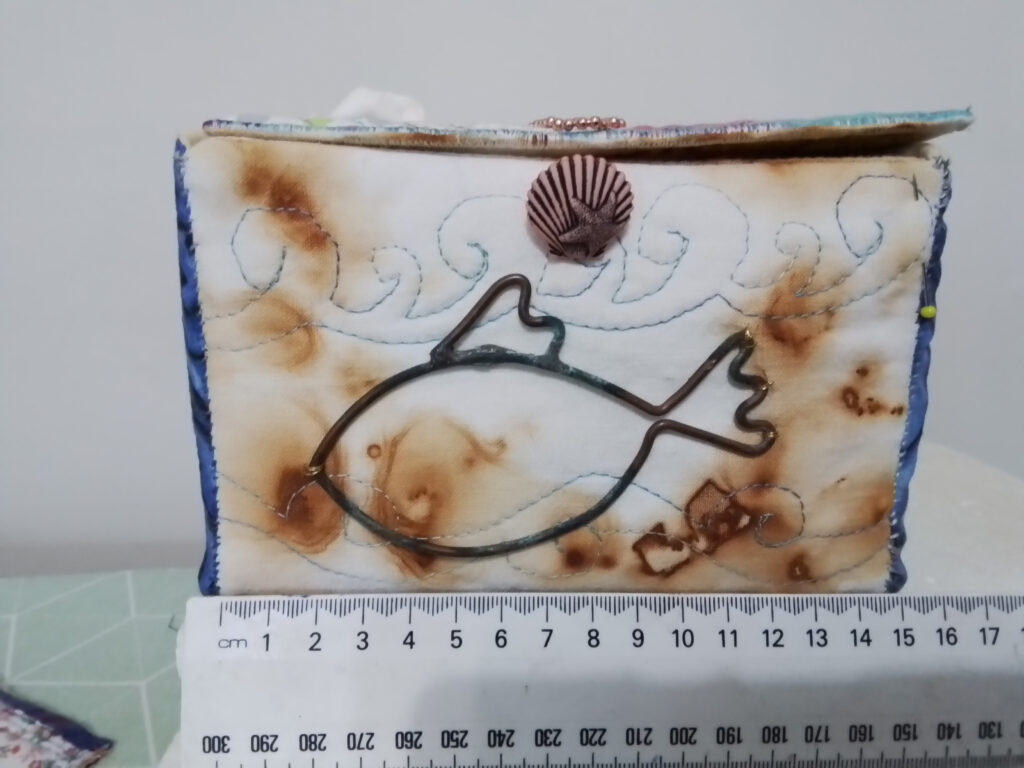 |
 |
Sandy Holden
Sounding A heartfelt note with my found object changed the direction of my project and I realized that there was a connection between the sender’s story and my family and so I made a box to hold and reflect that story. Included with my object was a piece of fabric created by the sender and this was also incorporated on the front and as the lining 100% cotton machine pieced and quilted |
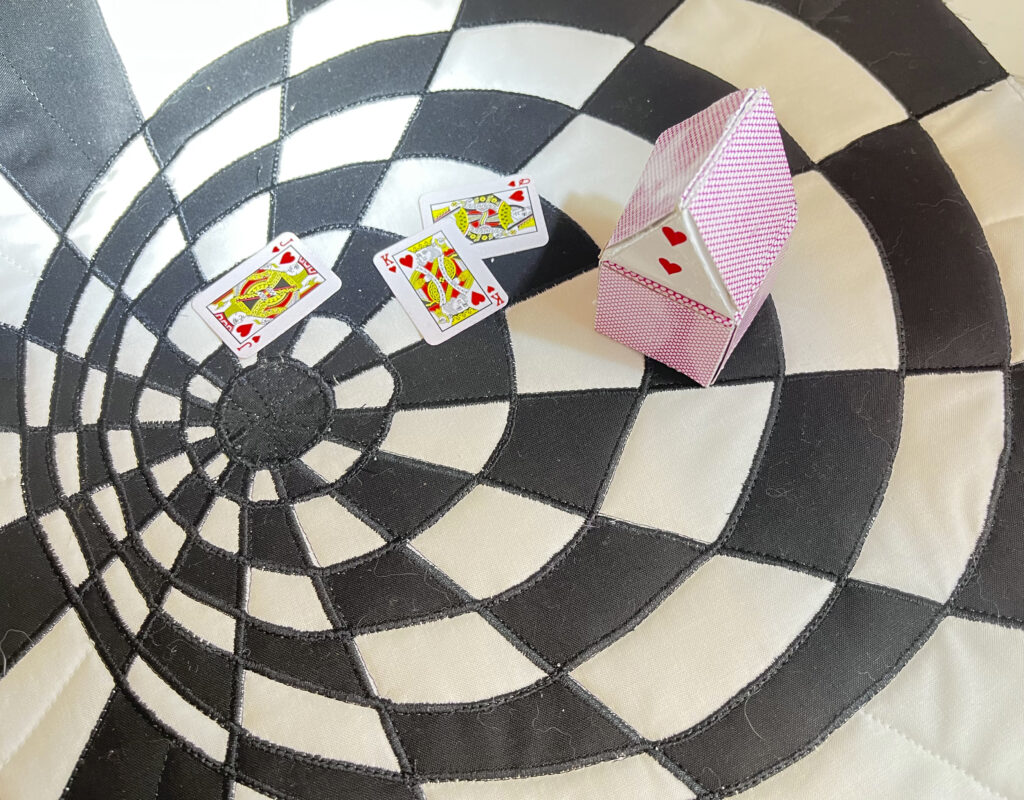 |
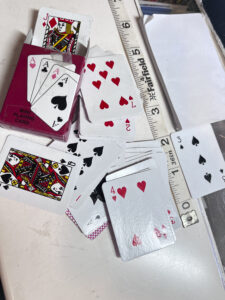 |
Jo Hollings
Spiralling inflation I was given a tiny set of playing cards. I built a wee house inspired by the hole that Alice from wonderland fell through. I was inspired to create a hole representing the differculty for some to get on the property ladder |
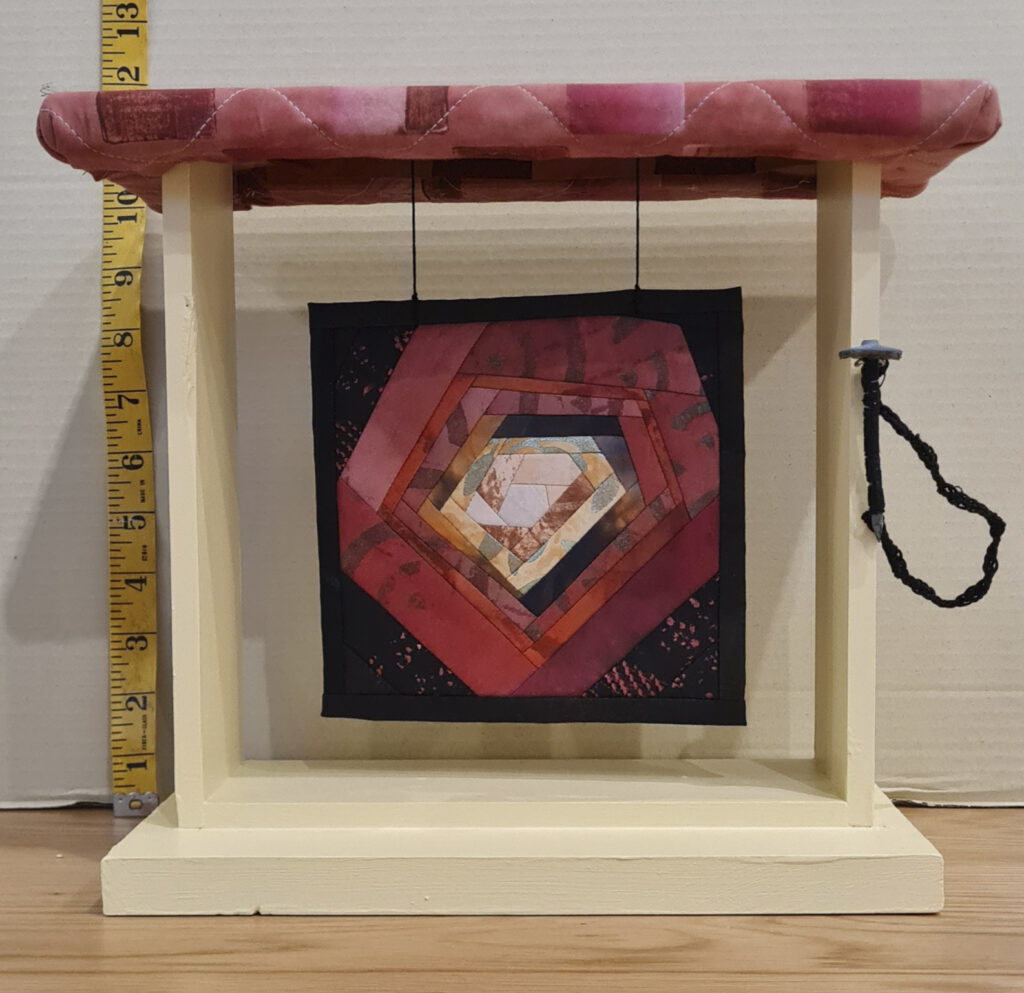 |
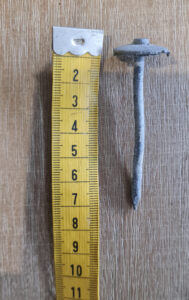 |
Catherine McDonald
Roof Shout The nail came from the roof of Barbara’s 140 year old house which she kept when they were replacing the roof. I saw this as a drum stick to hit a gong for dinner or in this case to hit the gong to say the new roof is on and it’s time for a roof shout! |
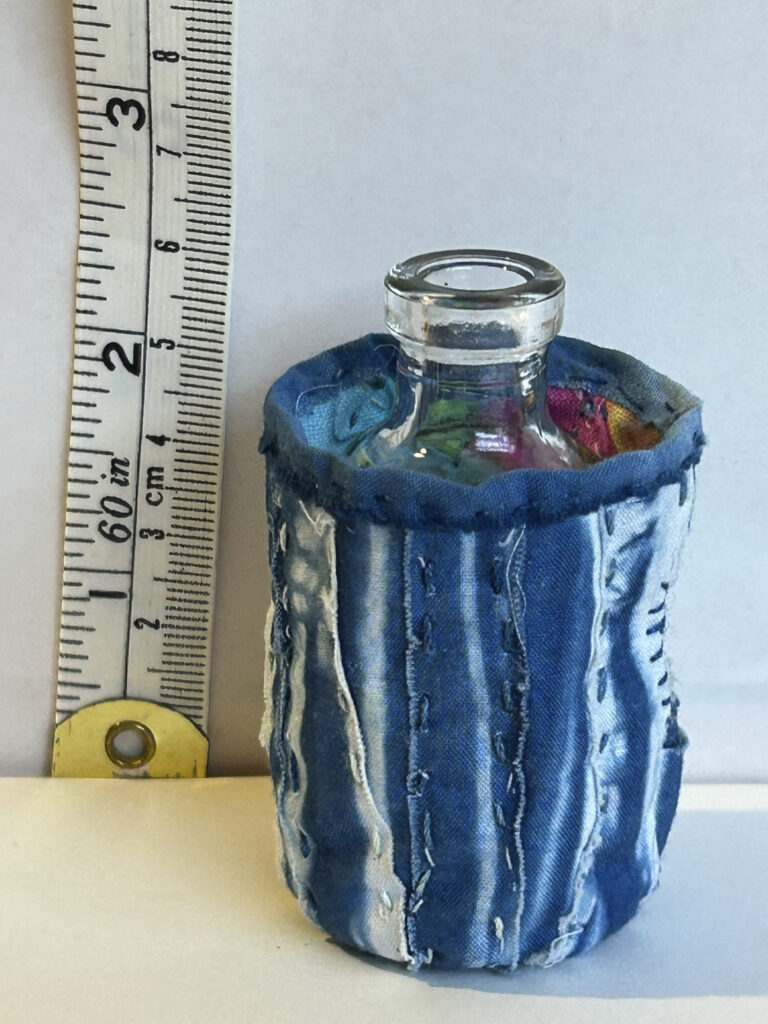 |
 |
Mary Napper
Tiny Treasure The little bottle contained SF 32 and was made in Auckland by the Clive Cosmetic Co. Ltd. Research lead me to understand that this would have been a remedy used regularly on the skin. I decided to make a fabric bowl to hold the bottle and absorb and spillage. Hand dyed fabrics were used to line the bowl as drips could enhance them. The indigo fabric could also be enhanced by spillage. Hand stitched there is a small window allowing the label to be checked. The bowl would enhance the treatment. |
 |
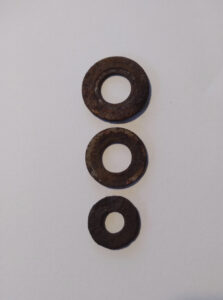 |
Jennifer Pope
Three Penny Washers Inspired by Wassily Kandinsky’s work of circles. With a Japanese Block, the largest washer sits in the middle. The cut-out from the Japanese Block was used for the second sized washer. The smallest washer sits at the bottom in the middle of a small circle. A simple embroidery line connects these three washers as well as other circles. Copper wire was used for one of the circles. Rust died fabric was used. Quilting was machined and hand stitched. |
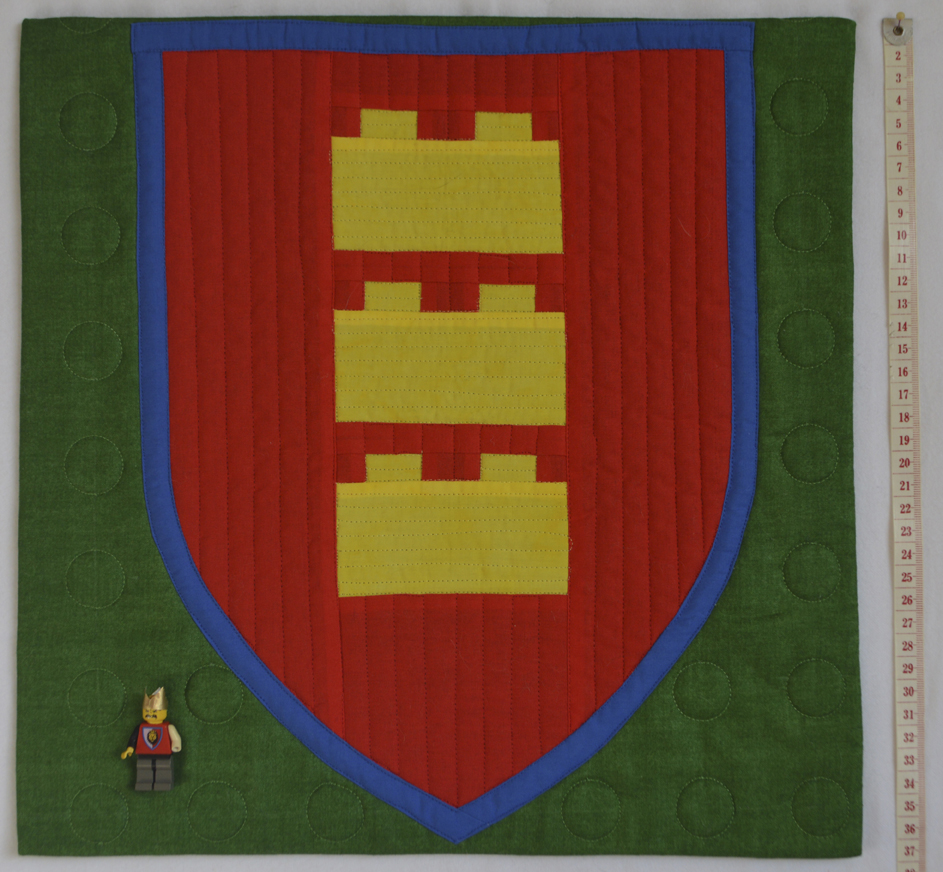 |
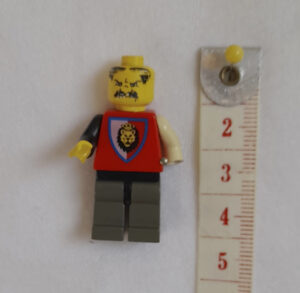 |
Judie Wert
The Shield of King Richard The odd object being a little man from a Lego kit found on the road inspired me to turn him into a king and create a shield for him. Since King Richard had three lions on his shield I thought 3 Lego blocks would be appropriate for a Lego “king”. |
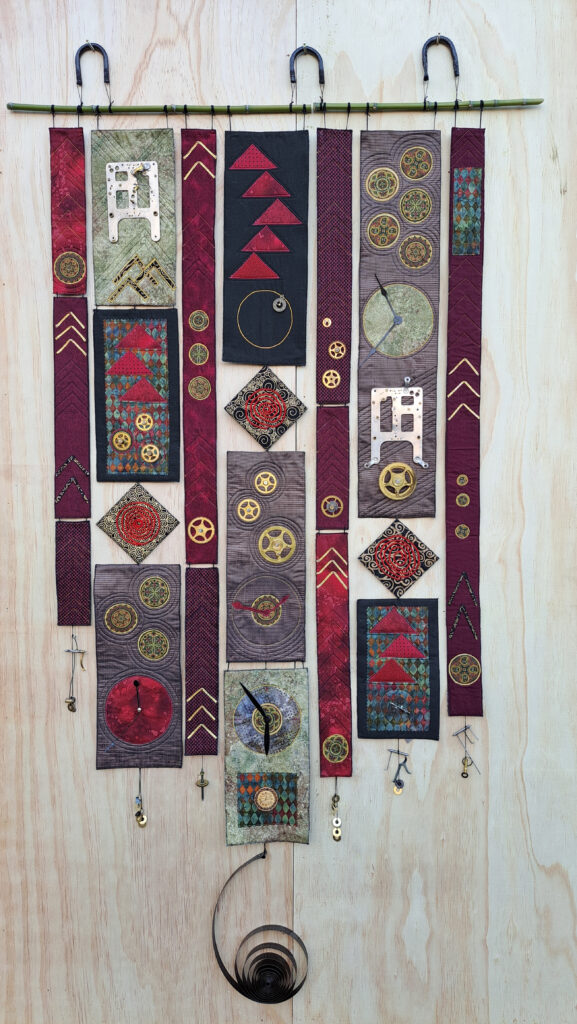 |
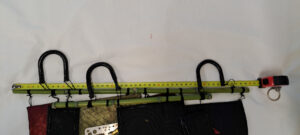 |
Barbara Wilson
Threads in Time The past, present and future are woven into the fabric of eternity. We unlock memories of the past through written records, oral tradition and the artefacts of archeology. In the present we see the passing of time in nature as birds migrate, plants grow, the path of the sun, and of course… the ubiquitous clock. We have hopes and dreams for the future which become our present, and then past. Our lives are but threads in the vastness of eternity. The 2 bamboo hangers & quilt fold into a 50 cube |
There were 20 entries to the odd object challenge, and 20 completely different objects. I had no idea who had made the works, and there were no recognisable styles that allowed me to guess. My criteria for judging were those listed – the object must be clearly visible and of a certain size – and then I looked at three things – how well the object was integrated into the work, the quality of the work, and the way it was displayed. Separately I evaluated the quality of the photography.
The works that placed first and second illustrate the wide variety of styles. Day’s Eye was a simple design, brilliantly executed, and incorporating a quite difficult object. Pearl Witherspoon had a lot of component parts, many showing different textile and quilting genres, and a relatively easy object.
Works that stood out for allowing the object to dictate the mood and the structure included: The Shield of King Richard, Faerie House, Egyptian, Shell We Journal and Tiny Treasure.
All the works featured good design ideas, but some were displayed better than others. Neutral, uncluttered backgrounds really do enhance the viewing experience, whether in a photograph, or in person.
There were several excellent photographs. Shell We Journal? won the photography section. In it we can clearly see the two orientations, and the texture of the fabric and stitching, the two images have no distractions and the colours read the same. They would make an exhibition entry a pleasure for a judge/juror to view. Also showing both sides, including the inside of the bag in one view, was Conference Junkie, nicely in focus.
The 2D works were easier to photograph, and most were square on, with the good focus. Just over half of the submissions were 3D, which made the photography part a little more difficult.
Issues that occurred in several photographs:
The solutions to the first two concern lighting. As in the photography seminar and most guidelines, it is important to have even lighting. That will include daylight, but not bright sunshine, and probably a light source off to one side. Overhead lighting is not your friend. While you need a slight shadow to give reality to your 3D work, or show up your quilting, that has to be subtle.
The solution to the focus is to take the camera further away from the object and crop later. A camera (and most people will be using their phones) will choose its focus and lighting from the box in the centre of the screen. If you are too close to the item, say the nearest corner of a box, the camera will focus on that front corner. By stepping back until the majority of the object is in the focus square, you will get a better result. For your detail shot, try to have the camera focusing on a flattish part of your design.
This advice is not new: take time, take many shots and choose the ones that are closest to true colour. If you have spent 10 to 30 hours on your work, don’t skimp on the work of presentation by thinking a couple of shots will do. Setting up for a minimum of half an hour and often a whole hour will show in your presentation. There are several online tutorials, e.g. https://www.artworkarchive.com/blog/4-steps-to-photographing-your-art-like-a-professional or this advice from Etsy, https://www.etsy.com/seller-handbook/article/154343798313.
Well done to all the participants for stepping up to the challenge in such creative ways, and congratulations to the winners.
